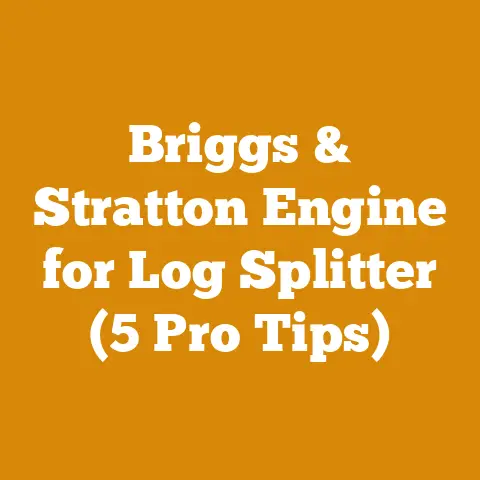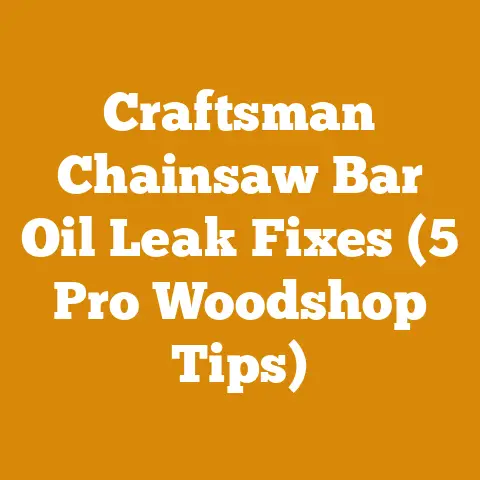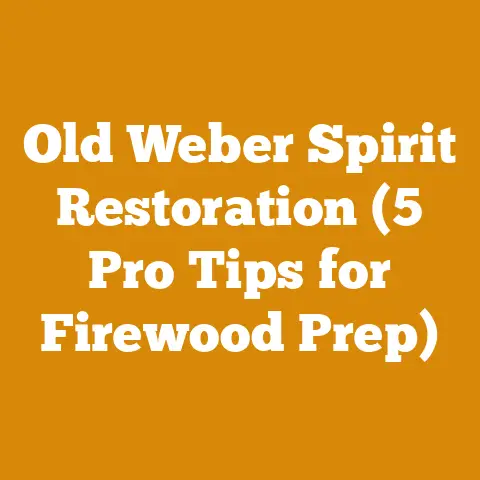The Best Brush Killer (5 Proven Herbicides for Tough Woody Brush)
As someone deeply immersed in the world of wood processing, logging, and firewood preparation, I understand the constant battle against unwanted vegetation. Brush, particularly tough woody brush, can quickly reclaim cleared land, choke out young trees in managed forests, and generally make life difficult. It’s a relentless adversary, and that’s why effective brush control is so crucial. This article is about finding the right tools to win that battle.
Effective brush control isn’t just about aesthetics; it’s about productivity, safety, and long-term sustainability. It minimizes hazards by clearing pathways, protects valuable timber resources, and reduces competition for sunlight, water, and nutrients. Furthermore, controlling brush helps prevent the spread of invasive species that can decimate entire ecosystems.
Understanding the Enemy: What is Woody Brush?
Woody brush refers to unwanted, persistent plants with woody stems that compete with desired vegetation. This includes:
- Trees: Undesirable tree species or saplings that are not part of the management plan.
- Shrubs: Multistemmed woody plants like buckthorn, honeysuckle, and blackberry.
- Vines: Climbing or trailing plants like poison ivy, bittersweet, and kudzu.
These plants often have deep, extensive root systems, making them difficult to eradicate by mechanical means alone. They can quickly regenerate from cut stumps or root fragments, requiring a more targeted approach.
The Arsenal: Herbicides as a Brush Control Tool
Herbicides are chemical substances designed to kill or inhibit the growth of plants. They are a valuable tool for brush control, especially when dealing with large areas or persistent species. However, it’s vital to use them responsibly and safely, following all label instructions and regulations.
Key Terms to Understand:
- Selective Herbicide: Kills specific types of plants while leaving others unharmed.
- Non-Selective Herbicide: Kills all plants it comes into contact with.
- Systemic Herbicide: Absorbed by the plant and translocated throughout its system, killing the entire plant, including the roots.
- Contact Herbicide: Kills only the parts of the plant it directly contacts.
- Pre-Emergent Herbicide: Applied to the soil before weeds emerge to prevent germination.
- Post-Emergent Herbicide: Applied to weeds after they have emerged from the soil.
For controlling tough woody brush, I primarily rely on post-emergent, systemic herbicides. These are absorbed by the leaves or stems and transported to the roots, ensuring a more complete kill.
Safety First: Handling Herbicides Responsibly
Before even considering specific herbicides, safety is paramount. I’ve seen firsthand the consequences of neglecting proper safety protocols. Always remember:
- Read the Label: The herbicide label is the law. It contains critical information about application rates, safety precautions, personal protective equipment (PPE), and environmental hazards.
- Wear Appropriate PPE: This typically includes gloves, eye protection, long sleeves, long pants, and closed-toe shoes. A respirator might be necessary depending on the herbicide and application method.
- Mix Herbicides in a Well-Ventilated Area: Avoid inhaling herbicide fumes.
- Avoid Spraying on Windy Days: Wind can carry herbicide droplets off-target, damaging desirable plants or contaminating water sources.
- Store Herbicides Safely: Keep herbicides in their original containers, clearly labeled, and out of reach of children and pets.
- Dispose of Empty Containers Properly: Follow label instructions for proper disposal. Never reuse herbicide containers.
- Be Aware of Environmental Hazards: Some herbicides can be harmful to aquatic life, beneficial insects, or other non-target organisms. Take precautions to minimize environmental impact.
Now, let’s examine five proven herbicides for tackling tough woody brush. Note: I am not endorsing any specific brand. Always consult with a local agricultural extension agent or certified applicator for recommendations specific to your region and target species.
Five Proven Herbicides for Tough Woody Brush
The following herbicides are commonly used and effective for controlling a wide range of woody brush species. However, effectiveness can vary depending on the species, application method, and environmental conditions.
1. Glyphosate
- Type: Non-selective, systemic
- Mechanism of Action: Inhibits an enzyme essential for plant growth.
- Target Species: Broad spectrum of grasses, broadleaf weeds, and woody plants.
- Application Methods: Foliar spray, cut-stump treatment, injection.
- Considerations: Non-selective, so it will kill any plant it contacts. Best used when targeting specific plants or in areas where all vegetation needs to be removed. Can be less effective on some woody species, especially when applied during dormancy.
- My Experience: I’ve used glyphosate extensively for clearing overgrown areas before planting trees. I typically apply it as a foliar spray in the late summer or early fall when plants are actively translocating nutrients to their roots. For cut-stump treatment, I apply it immediately after cutting the stump to prevent resprouting.
Detailed Application Guide for Glyphosate:
Foliar Spray:
- Preparation: Ensure desirable plants are protected from overspray. Use a sprayer with a nozzle that produces large droplets to minimize drift.
- Mixing: Mix glyphosate according to the label instructions. The concentration will vary depending on the target species and application method. Typically, a concentration of 1-3% is used for foliar applications.
- Application: Spray the foliage of the target plants thoroughly, ensuring complete coverage. Avoid spraying during windy conditions or when rain is expected within 24 hours.
- Timing: Apply when plants are actively growing, typically in the late spring or early fall. Avoid applying during drought or extreme heat.
- Follow-up: Monitor the treated area for regrowth and reapply as needed.
Cut-Stump Treatment:
- Cutting: Cut the brush close to the ground with a chainsaw, axe, or brush cutter. Ensure the cut is clean and horizontal. Chainsaw Tip: I prefer using a Stihl MS 261 C-M for this type of work. Its power-to-weight ratio and electronic engine management system make it efficient and reliable.
- Application: Immediately after cutting, apply glyphosate concentrate (undiluted or according to label instructions) to the entire cut surface of the stump. Use a paintbrush, spray bottle, or specialized stump treatment applicator.
- Timing: Apply as soon as possible after cutting, ideally within minutes. The longer the delay, the less effective the treatment.
- Considerations: This method is particularly effective for preventing resprouting of woody species. Be careful to avoid contact with desirable plants.
Cost: Glyphosate is generally one of the most affordable herbicides. A 2.5-gallon container of concentrated glyphosate typically costs between $50 and $100.
2. Triclopyr
- Type: Selective, systemic
- Mechanism of Action: Disrupts plant growth hormones.
- Target Species: Broadleaf weeds and woody plants, particularly effective on species like maple, oak, and blackberry.
- Application Methods: Foliar spray, cut-stump treatment, basal bark treatment.
- Considerations: Selective, meaning it is less likely to harm grasses. Basal bark treatment is effective for controlling trees up to a certain diameter (typically 6 inches) without cutting them down. Can be more expensive than glyphosate.
- My Experience: Triclopyr is my go-to herbicide for controlling blackberry and other thorny brush in my woodlot. I often use the basal bark treatment on smaller trees that I want to eliminate without disturbing the surrounding vegetation.
Detailed Application Guide for Triclopyr:
Foliar Spray:
- Preparation: Similar to glyphosate, protect desirable plants from overspray.
- Mixing: Mix triclopyr according to label instructions. The concentration will vary depending on the target species and application method. A common concentration is 1-4%.
- Application: Spray the foliage of the target plants thoroughly, ensuring complete coverage. Avoid spraying during windy conditions or when rain is expected within 24 hours.
- Timing: Apply when plants are actively growing, typically in the late spring or early fall.
- Follow-up: Monitor the treated area for regrowth and reapply as needed.
Cut-Stump Treatment:
- Cutting: Cut the brush close to the ground.
- Application: Apply triclopyr concentrate (undiluted or according to label instructions) to the entire cut surface of the stump.
- Timing: Apply as soon as possible after cutting.
- Considerations: Similar to glyphosate, this method is effective for preventing resprouting.
Basal Bark Treatment:
- Preparation: This method is best suited for trees with a diameter of 6 inches or less.
- Mixing: Mix triclopyr with a penetrating oil according to label instructions. The oil helps the herbicide penetrate the bark. A common ratio is 20% triclopyr and 80% oil.
- Application: Apply the mixture to the lower 12-18 inches of the tree trunk, completely encircling the circumference. Use a low-pressure sprayer to avoid runoff.
- Timing: Apply during the dormant season (late fall to early spring) when the bark is more absorbent.
- Considerations: This method is less disruptive than cutting down the tree. It is effective for controlling trees in sensitive areas where you don’t want to disturb the soil or surrounding vegetation.
Cost: Triclopyr is generally more expensive than glyphosate. A 2.5-gallon container of concentrated triclopyr typically costs between $100 and $200.
3. Imazapyr
- Type: Non-selective, systemic
- Mechanism of Action: Inhibits an enzyme essential for amino acid synthesis.
- Target Species: Broad spectrum of grasses, broadleaf weeds, and woody plants. Particularly effective on tough-to-control species like kudzu and tree-of-heaven.
- Application Methods: Foliar spray, cut-stump treatment, soil application.
- Considerations: Non-selective, so it will kill any plant it contacts. Can have residual activity in the soil, preventing regrowth for an extended period. Use with caution near desirable plants or water sources.
- My Experience: I’ve used imazapyr to control invasive tree-of-heaven along a logging road. Its residual activity is a double-edged sword – it effectively prevents regrowth but requires careful application to avoid harming desirable vegetation.
Detailed Application Guide for Imazapyr:
Foliar Spray:
- Preparation: Protect desirable plants from overspray.
- Mixing: Mix imazapyr according to label instructions. The concentration will vary depending on the target species and application method.
- Application: Spray the foliage of the target plants thoroughly, ensuring complete coverage.
- Timing: Apply when plants are actively growing.
- Follow-up: Monitor the treated area for regrowth.
Cut-Stump Treatment:
- Cutting: Cut the brush close to the ground.
- Application: Apply imazapyr concentrate (undiluted or according to label instructions) to the entire cut surface of the stump.
- Timing: Apply as soon as possible after cutting.
- Considerations: Be aware of the potential for residual activity in the soil.
Soil Application:
- Preparation: This method is typically used for controlling brush around structures or in areas where foliar application is not feasible.
- Application: Apply imazapyr granules or liquid to the soil around the base of the target plants. Follow label instructions for application rates.
- Timing: Apply in the early spring before plants begin to actively grow.
- Considerations: This method can have a significant impact on surrounding vegetation. Use with extreme caution near desirable plants or water sources.
Cost: Imazapyr is generally in the mid-range in terms of cost. A 2.5-gallon container of concentrated imazapyr typically costs between $150 and $250.
4. 2,4-D
- Type: Selective, systemic
- Mechanism of Action: Disrupts plant growth hormones.
- Target Species: Broadleaf weeds and some woody plants.
- Application Methods: Foliar spray.
- Considerations: Selective, meaning it is less likely to harm grasses. Can be volatile and prone to drift, especially in hot weather. Not as effective on some tough woody species as other herbicides.
- My Experience: I’ve used 2,4-D for controlling broadleaf weeds in pastures and along logging roads. It’s a good option for maintaining grassy areas while suppressing unwanted broadleaf vegetation.
Detailed Application Guide for 2,4-D:
Foliar Spray:
- Preparation: Protect desirable plants from overspray. Be particularly careful to avoid drift onto sensitive crops like tomatoes and grapes.
- Mixing: Mix 2,4-D according to label instructions.
- Application: Spray the foliage of the target plants thoroughly, ensuring complete coverage.
- Timing: Apply when plants are actively growing and temperatures are moderate. Avoid applying during hot, windy conditions.
- Follow-up: Monitor the treated area for regrowth.
Cost: 2,4-D is generally one of the most affordable selective herbicides. A 2.5-gallon container of concentrated 2,4-D typically costs between $40 and $80.
5. Metsulfuron-methyl
- Type: Selective, systemic
- Mechanism of Action: Inhibits an enzyme essential for amino acid synthesis.
- Target Species: Broadleaf weeds and some woody plants. Particularly effective on species like blackberry, multiflora rose, and kudzu.
- Application Methods: Foliar spray, cut-stump treatment.
- Considerations: Selective, meaning it is less likely to harm grasses. Can be effective at very low application rates. Be aware of potential for soil residual activity.
- My Experience: I’ve used metsulfuron-methyl to control multiflora rose in a pasture. Its effectiveness at low rates makes it a cost-effective option for large-scale brush control.
Detailed Application Guide for Metsulfuron-methyl:
Foliar Spray:
- Preparation: Protect desirable plants from overspray.
- Mixing: Mix metsulfuron-methyl according to label instructions. Application rates are typically very low (e.g., ounces per acre).
- Application: Spray the foliage of the target plants thoroughly, ensuring complete coverage.
- Timing: Apply when plants are actively growing.
- Follow-up: Monitor the treated area for regrowth.
Cut-Stump Treatment:
- Cutting: Cut the brush close to the ground.
- Application: Apply metsulfuron-methyl solution (according to label instructions) to the entire cut surface of the stump.
- Timing: Apply as soon as possible after cutting.
Cost: Metsulfuron-methyl is relatively expensive per pound, but its low application rates make it a cost-effective option for large-scale brush control. A small container (e.g., 1 pound) can treat a significant area.
Beyond Herbicides: Integrated Brush Management
While herbicides are a powerful tool, they are most effective when used as part of an integrated brush management plan. This involves combining different methods to achieve long-term control.
Key Components of an Integrated Brush Management Plan:
- Prevention: Preventing the introduction and spread of invasive species is the most cost-effective approach. This includes cleaning equipment before moving it between sites, using certified weed-free seed, and controlling invasive plants along roads and trails.
- Mechanical Control: Cutting, mowing, and hand-pulling can be effective for controlling small infestations of brush. I often use a forestry mulcher attached to a skid steer for clearing large areas of brush. This machine grinds up the brush into small pieces, which decompose and add organic matter to the soil. A typical mulcher can process brush up to 8 inches in diameter.
- Cultural Control: Practices that promote the growth of desirable vegetation can help suppress brush. This includes proper fertilization, irrigation, and grazing management.
- Biological Control: Using natural enemies of brush species, such as insects or fungi, to control their populations. This is often a long-term approach that requires careful research and planning.
- Prescribed Burning: In some ecosystems, prescribed burning can be an effective tool for controlling brush and promoting the growth of fire-adapted species. I’ve participated in several prescribed burns to manage brush in oak savannas. The fire top-kills the brush, allowing the oak trees to regenerate.
Case Studies: Brush Control in Action
To illustrate the principles of brush control, let’s look at a couple of real-world case studies:
Case Study 1: Reclaiming a Logging Landing
A logging operation had left a large landing area heavily disturbed and prone to brush invasion. The primary goal was to re-establish a grass cover to prevent erosion and provide wildlife habitat.
- Assessment: The landing was surveyed to identify the dominant brush species (primarily blackberry, honeysuckle, and tree-of-heaven).
- Mechanical Control: The area was mowed to remove the bulk of the brush.
- Herbicide Application: Glyphosate was applied as a foliar spray to the remaining brush, targeting the resprouts.
- Seeding: The area was seeded with a mixture of native grasses and legumes.
- Maintenance: The area was monitored for regrowth of brush, and spot treatments of triclopyr were applied as needed.
Result: Within two years, the landing was successfully converted to a grass cover, providing erosion control and wildlife habitat.
Case Study 2: Controlling Invasive Vines in a Woodlot
A woodlot was heavily infested with bittersweet vines, which were choking out valuable timber trees. The goal was to control the vines without harming the trees.
- Assessment: The extent of the vine infestation was mapped.
- Mechanical Control: The vines were cut at the base of the trees to sever their connection to the roots.
- Herbicide Application: Triclopyr was applied as a cut-stump treatment to the cut ends of the vines.
- Maintenance: The woodlot was monitored for regrowth of vines, and spot treatments of triclopyr were applied as needed.
Result: The bittersweet vines were effectively controlled, allowing the timber trees to recover and thrive.
The Importance of Timing and Environmental Factors
The success of any brush control program hinges on understanding the importance of timing and environmental factors. Applying herbicides at the wrong time of year, or under unfavorable weather conditions, can significantly reduce their effectiveness.
Timing:
- Active Growth: Herbicides are generally most effective when plants are actively growing and translocating nutrients to their roots. This is typically in the late spring or early fall.
- Dormancy: Basal bark treatments are often most effective when applied during the dormant season.
- Avoid Extreme Conditions: Avoid applying herbicides during drought, extreme heat, or freezing temperatures.
Environmental Factors:
- Wind: Avoid spraying on windy days to prevent drift.
- Rain: Avoid spraying when rain is expected within 24 hours, as the herbicide may be washed off.
- Temperature: Some herbicides are more volatile at high temperatures.
- Soil Moisture: Soil moisture can affect the uptake of herbicides by plants.
Final Thoughts: A Sustainable Approach to Brush Control
Brush control is an ongoing process, not a one-time event. A sustainable approach involves:
- Prevention: Preventing the introduction and spread of invasive species.
- Early Detection and Rapid Response: Identifying and controlling small infestations before they become large problems.
- Integrated Management: Combining different methods to achieve long-term control.
- Monitoring and Evaluation: Regularly monitoring the treated area to assess the effectiveness of the control measures and make adjustments as needed.
By following these principles, I believe you can effectively manage brush and maintain healthy, productive landscapes. Remember to always prioritize safety and environmental responsibility in all your brush control activities. And never hesitate to consult with a local expert for guidance specific to your situation.






